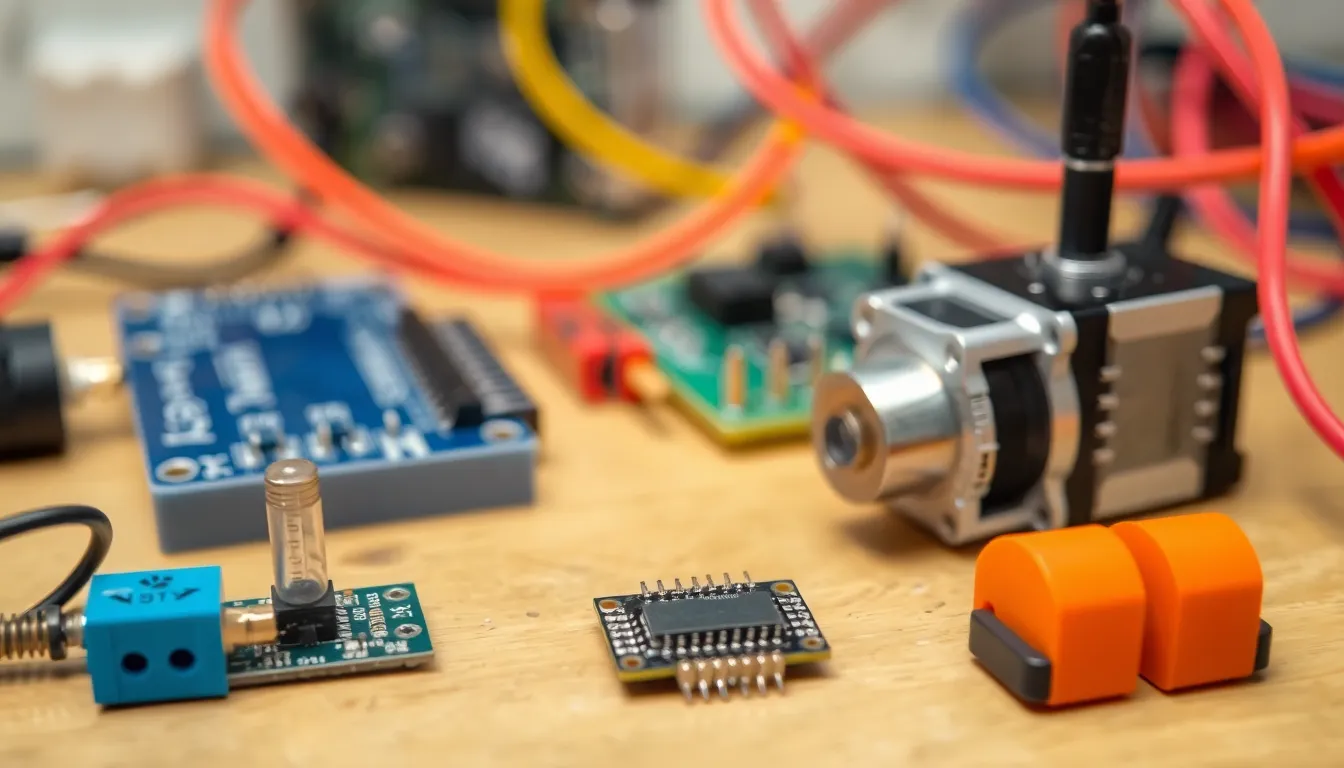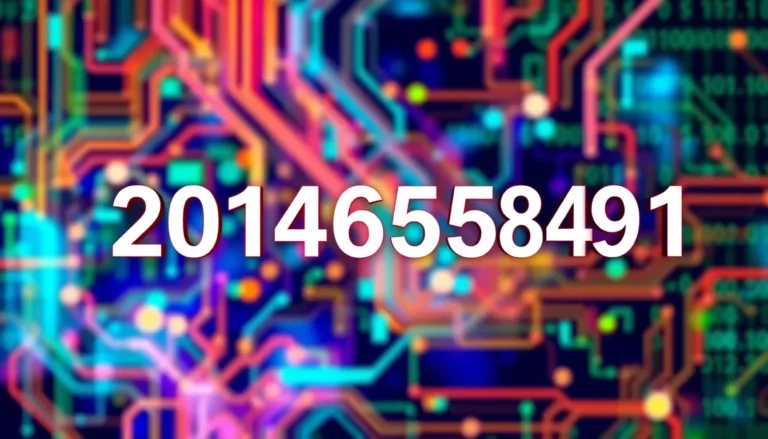The rise of the Internet of Things (IoT) has transformed how devices communicate and interact, making embedded systems a crucial component in this evolution. These compact, specialized systems are designed to perform dedicated functions within larger networks, enabling seamless connectivity and data exchange. As everyday objects become smarter, the demand for efficient embedded systems continues to grow.
From smart home devices to industrial automation, embedded systems play a vital role in enhancing functionality and user experience. They process data in real-time, ensuring that devices respond quickly and accurately to user commands and environmental changes. Understanding the intricacies of embedded systems in IoT not only reveals their potential but also highlights the innovative solutions they bring to various industries.
Table of Contents
ToggleOverview of Embedded Systems IoT
Embedded systems in the Internet of Things (IoT) form the backbone of modern smart devices. These systems integrate hardware and software to perform dedicated functions within a larger network. Embedded systems enable devices to collect data, analyze information, and communicate efficiently.
Embedded systems feature microcontrollers or microprocessors that execute tasks in real time. They process sensor inputs, control actuators, and manage communication protocols. These capabilities enhance device responsiveness and overall performance.
Key components of embedded systems include:
- Sensors: Measure environmental parameters, such as temperature, humidity, and motion.
- Actuators: Execute physical actions based on commands from the system.
- Communication Modules: Facilitate data transmission over wireless or wired networks.
- Power Management: Ensures efficient energy consumption, extending battery life in mobile applications.
Industries leverage embedded systems IoT for various applications. For example:
- Healthcare: Wearable devices monitor vital signs and transmit data to medical professionals in real time.
- Smart Homes: IoT-enabled appliances communicate with users and other devices, optimizing energy consumption and improving convenience.
- Manufacturing: Embedded systems control machinery, enhancing production efficiency and reducing downtime.
The integration of embedded systems in IoT devices promotes a more connected environment, advancing automation and user engagement in daily life. These innovations lead to smarter solutions and improved decision-making processes across numerous sectors.
Key Components of Embedded Systems IoT

Embedded systems in IoT consist of critical components that facilitate effective communication and data processing. The following components are fundamental in creating responsive and efficient smart devices.
Sensors and Actuators
Sensors detect environmental changes and convert them into electrical signals. These signals provide data regarding physical parameters such as temperature, humidity, and motion. For instance, a temperature sensor may send real-time data to a smart thermostat to adjust heating or cooling automatically. Actuators translate electronic signals into physical actions; they control mechanisms like motors and valves. In smart home systems, actuators can operate smart locks or open and close curtains. Together, sensors and actuators enable devices to monitor conditions and respond dynamically, enhancing automation and user experience.
Microcontrollers and Processors
Microcontrollers serve as the brains of embedded systems, executing control functions by processing data gathered from sensors. They integrate key components like memory and input/output peripherals on a single chip. For example, a microcontroller in a fitness tracker processes sensor data to monitor heart rate and step count, ensuring accurate performance. Processors, including more powerful microprocessors, handle complex tasks requiring higher computational power, such as machine learning algorithms for predictive analysis. The selection of microcontrollers and processors directly impacts device efficiency, performance, and ability to support increased functionalities, driving innovations in IoT applications.
Applications of Embedded Systems IoT
Embedded systems play a crucial role in various sectors by enabling intelligent functionality through IoT integration. The following applications showcase their significance across different fields.
Smart Homes
Embedded systems enhance smart home technologies by enabling device interconnectivity and automation. Smart thermostats adjust temperatures based on user preferences, while intelligent lighting systems optimize energy use. Security systems equipped with cameras and motion detectors provide real-time alerts, improving safety. In addition, embedded systems support voice-activated assistants that manage various devices within the home environment, ensuring convenient and efficient control.
Industrial Automation
In industrial automation, embedded systems streamline processes and improve operational efficiency. Automated machinery relies on embedded solutions for precision control and monitoring. For example, robotics equipped with embedded sensors can perform tasks like assembly and quality control with high accuracy. Additionally, predictive maintenance systems analyze machinery performance data to anticipate failures, reducing downtime and maintenance costs. The use of embedded systems in manufacturing enhances productivity and safety in work environments.
Healthcare Solutions
Embedded systems revolutionize healthcare solutions by tracking patient data and enhancing medical device functionality. Wearable health monitors collect vital signs and transmit them to healthcare providers in real-time, allowing for timely interventions. Smart drug delivery systems use embedded technology to administer medication based on patient needs. Medical imaging devices employ embedded systems for processing and analyzing images, facilitating accurate diagnoses. The integration of embedded systems in healthcare improves patient outcomes and fosters more personalized care.
Challenges in Embedded Systems IoT
Embedded systems in IoT face several challenges that can hinder their effectiveness and adoption. Key issues include security concerns and scalability challenges.
Security Concerns
Security remains a critical challenge in embedded systems IoT. Vulnerabilities in these systems can lead to unauthorized access, data breaches, and potential physical harm. Examples include unpatched software, weak authentication methods, and lack of encryption. Attackers can exploit these weaknesses to gain control over devices or intercept sensitive data. As numerous devices connect to the internet, threat vectors multiply, necessitating robust security protocols. Manufacturers must implement regular security updates and adopt best practices to mitigate risks effectively.
Scalability Issues
Scalability poses another challenge for embedded systems in IoT. As the number of connected devices increases, maintaining performance and efficiency becomes difficult. Systems must support a growing network without degradation in response times or reliability. The ability to manage large data volumes generated by numerous devices is crucial for real-time analysis. For instance, systems need to utilize cloud computing resources or edge computing solutions to process data effectively. Developers face the task of designing architecture that accommodates future growth while ensuring interoperability across diverse devices and platforms.
Future Trends in Embedded Systems IoT
Innovation drives the future of embedded systems in IoT, with several key trends emerging. These trends shape development, enhance functionality, and transform user experiences.
- Edge Computing
Edge computing reduces latency by processing data closer to its source. This trend allows embedded systems to make real-time decisions without relying heavily on cloud infrastructure. For example, factory automation systems analyze data from machines locally, enabling faster responses to equipment malfunctions.
- AI Integration
Artificial intelligence (AI) enhances embedded systems’ capabilities, allowing for advanced analytics and decision-making. AI algorithms can process data from sensors, improving predictive maintenance and anomaly detection in industrial applications. For instance, smart cameras can identify security threats in real time, adapting to changing conditions.
- Energy Efficiency
Energy-efficient designs ensure longevity and sustainability in IoT devices. Innovations like energy harvesting and low-power components drive this trend, allowing devices to operate on minimal power. For example, smart sensors that draw energy from their environment can reduce the need for frequent battery replacements.
- Interoperability Standards
Developing interoperability standards promotes compatibility among diverse IoT devices. Unified protocols facilitate seamless communication among systems, enhancing user experience and device functionality. Organizations and consortiums are working towards establishing standards that simplify integration across the ecosystem.
- Enhanced Security Measures
Security remains a priority as the number of connected devices rises. Future trends focus on implementing advanced security measures, such as hardware-based security and encryption protocols. For instance, secure elements within embedded systems can safeguard sensitive data from unauthorized access.
- 5G Connectivity
The rollout of 5G technology significantly impacts embedded systems in IoT by providing faster data transmission speeds and increased network capacity. This shift supports applications requiring real-time data processing, such as autonomous vehicles and smart city infrastructure. The low latency of 5G enables devices to communicate seamlessly, enhancing operational efficiency.
- Remote Management and Updates
Remote management capabilities simplify firmware updates and troubleshooting for embedded systems. Over-the-air (OTA) updates streamline device maintenance while ensuring security patches are implemented quickly. This trend reduces downtime and improves the overall reliability of IoT devices.
The convergence of these trends in embedded systems IoT shapes future innovations and influences various industries. Adopting these advancements paves the way for smarter, more responsive environments, facilitating greater integration and user engagement.
The integration of embedded systems in IoT is a game-changer for various industries. These systems not only enhance device functionality but also drive innovation and efficiency. As technology evolves, the focus on security and interoperability will be crucial in addressing challenges that arise from an expanding network of connected devices.
Future developments like edge computing and AI integration will further empower embedded systems, leading to smarter applications and improved user experiences. The ongoing advancements in energy efficiency and 5G technology promise to revolutionize how devices communicate and operate.
With these trends shaping the future, embedded systems will continue to play a pivotal role in creating a more connected and responsive world.



